I had a chance to climb on some ice this winter thatwasunique. Was to me anyway.
I had thought I had seen hard black ice previous. Uncomfortable but workable. But some of the stuff we got on in Chamonixwas damn near bullet proof. And I actually know what real "bullet proof " is by USDOJ standards. This was IIIA no problem. Ceramic plate hard. Going for a solid III or IV rating hard. Hard, cold and dry. Some times as much rock and sand, as ice.
I had thought over time Ipretty muchfigured out how to get a decent belay on ice quickly. Typically takes only a few minutes and I'm done. Nothing fancy mind you. Two screws, two tools to the hilt. Clove the screws on a good day, clip a tool out of the loop may beand were are off to the races. Nothing fancy. I can do fancy just don't chose to generally.
Only once have I failed to get an anchor...that in the upper bowl on Slipstream. Even in the old days when we already knew the screws we were using wouldn't work in some ice we'd just keep climbing in a similar situation.Never have I spent an hour trying to get a belay on ice...until this winter.

Matt (high middle of pic) above tied off screws and well deserved rock pro....finally.
Likely obvious but alpine ice isn't waterfall ice.I spent an hr we could ill afford trying to get two decent screws into the belay from where this picture is taken. You might reasonably ask why not rock gear there? And it would be a reasonable question. We had just climbed 250m of hard, (like rocks are hard)north facing ice with a foot or so of fresh snow on it and my patience was wearing thin. I actually climbed over to the rock thinking I'd be able to get something inwhere the picture is, easily. ( I seldom can't in a minute or less on rock) It was prefect granite for chrimney's sake! By the time I realised rock gear wasn't going to be easy I was determined to grovel, dig or full on excavate toget ice..any ice.
What ice that I could/should have gotten a screw into normally I was coming up dry. I'd get a bite, a couple of 1/4 turns to a start. Then the ice turned to theconsistency of riceand the screw failed to bite as the tip, plugged up with ice. Over and over again. Clean the tip and try, clean the tip and try. Nothing in the tube.
Six holes.....yes I counted. And many failed ice screw placements later I gave up (i gave up!?) ...tied the two shitty screws off, covered them with snow, reset my tools, tied them off and said "climb". Surely not not all that thrilled with the screws or the time wasted. We should have just started climbing together so I would/could have found better ice. Bad, really bad, judgement call on my part in several ways.
I had covered the anchors because I knewmy partner was not going to bepleased. With the gear or with me. Hell! I wasn't pleased and at this point was feeling like a total failure. WTF happened here? A couple of things.
The ice was really old and hard. It was shallow. I dinged 3 screws trying, I know. But and here it comes....the screwswere all new (as in brand new) BD Express screws. I had decided to make a real effort to use the BDs in the alpine on this trip. Lighter by a few grams, rack easier and all.......
Even if the BD's are a bit harder to place, which has been my experience over time, it is only alpine ice. How hard can it be? "
It aint going to ever matter." Ya, that was a dumb answer. And this was a "easy" climb. Just the fact that the ice wasn't being cooperative made it, well, not so easy.
A number of things stood out to me on this particular climb. New snow on the approach and the easy angled ice,the cold temps and the ice quality.It was hard to get takers for a trip back to that set of gullies ;)
What I did fine when I made it back the next week was...similar snow conditions. And thesame ice conditions. Likely a tiny bit warmer but that would be only a guess and if so notby much.
But I brought a majority of Grivel Helix screws this time. Fool me twice and all. Amazingly enough...every screw was sunk to thehilt first try. Nothing tied off and no time wasted on bad anchors.
To be fair. I knew where I was going, where there was good/better ice on routeand whereto avoid another dry hole. But still......if I didn't think there was a difference...a big difference..I wouldn't be writing about it. With a little help my partner was able to climb"the obvious line" that wasn't all that obvious first time around or for the localsthat were following us that day.
I have a full rack of the newest BD and Grivel screws and no horse in the race.. YMMV but that is my 2 cents from this experience.

Looking down from that same belay....great snow ledge anyway :)
Sadly, no, the beautiful and warm sunshine never touched the belay.
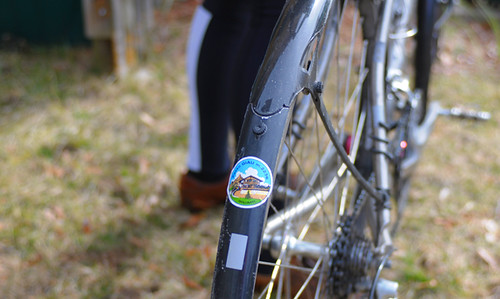
 Matt (high middle of pic) above tied off screws and well deserved rock pro....finally.
Matt (high middle of pic) above tied off screws and well deserved rock pro....finally. Looking down from that same belay....great snow ledge anyway :)
Looking down from that same belay....great snow ledge anyway :) 






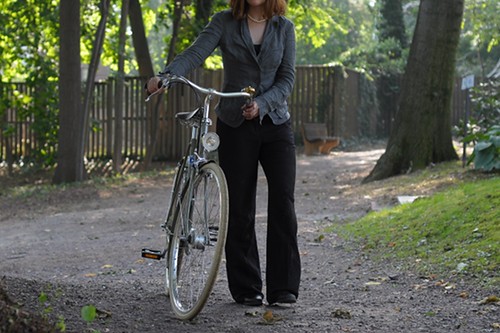 One question I am often asked about cycling to work, is how to avoid wrinkles on business and formal attire. I don't have many pictures of myself dressed up, but I do cycle in suits and dresses that fall into the business/ formal category. And rather than avoid wrinkles, I tend to choose clothing that either doesn't wrinkle easily, or that is meant to look wrinkled. This habit is a hold-over from a life of constant travel combined with a hatred of dry-cleaning and ironing boards, and it lends itself well to cycling. Here are some suggestions I can make from personal experience.
One question I am often asked about cycling to work, is how to avoid wrinkles on business and formal attire. I don't have many pictures of myself dressed up, but I do cycle in suits and dresses that fall into the business/ formal category. And rather than avoid wrinkles, I tend to choose clothing that either doesn't wrinkle easily, or that is meant to look wrinkled. This habit is a hold-over from a life of constant travel combined with a hatred of dry-cleaning and ironing boards, and it lends itself well to cycling. Here are some suggestions I can make from personal experience. I am also a fan of "twist-dried" designs. There may be a formal name for this process that escapes me, so someone please help me out. But what I mean is that there is a style of shirts, skirts, even evening dresses where the wrinkles are part of the garment's very design. This is achieved by drying the article of clothing in a wrung-out, or twisted manner. The resulting wrinkles are clearly intentional. They add a sense of structure and the illusion of subtle colour variation to the fabric once it is dry. Typically, the twist-dried effect is produced by the manufacturer, but you can create it on your own by simply drying any shirt, skirt, or dress (crisp cottons and silks with no pockets work best) in this fashion. Having wrinkles as an inherent design element of your outfit eliminates the need to worry about them.
I am also a fan of "twist-dried" designs. There may be a formal name for this process that escapes me, so someone please help me out. But what I mean is that there is a style of shirts, skirts, even evening dresses where the wrinkles are part of the garment's very design. This is achieved by drying the article of clothing in a wrung-out, or twisted manner. The resulting wrinkles are clearly intentional. They add a sense of structure and the illusion of subtle colour variation to the fabric once it is dry. Typically, the twist-dried effect is produced by the manufacturer, but you can create it on your own by simply drying any shirt, skirt, or dress (crisp cottons and silks with no pockets work best) in this fashion. Having wrinkles as an inherent design element of your outfit eliminates the need to worry about them.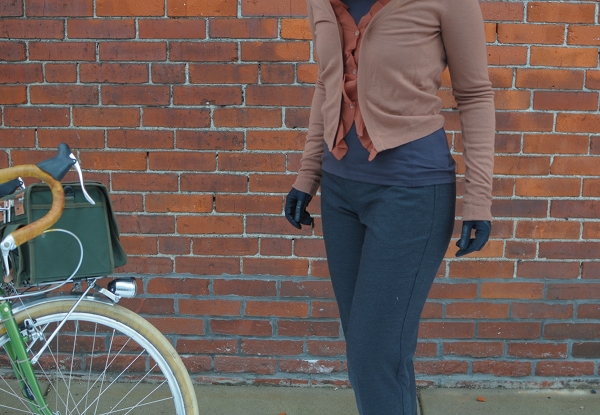 If your dress code limits you to more conventional suiting, I have found that wool skirts and trousers tend to be more forgiving as far as wrinkling goes than other fabrics. They still wrinkle, just less so. Not getting on and off the bicycle saddle every time I stop (but leaning the bike and putting a toe down instead) has been helpful in preventing wrinkles from forming as well.
If your dress code limits you to more conventional suiting, I have found that wool skirts and trousers tend to be more forgiving as far as wrinkling goes than other fabrics. They still wrinkle, just less so. Not getting on and off the bicycle saddle every time I stop (but leaning the bike and putting a toe down instead) has been helpful in preventing wrinkles from forming as well.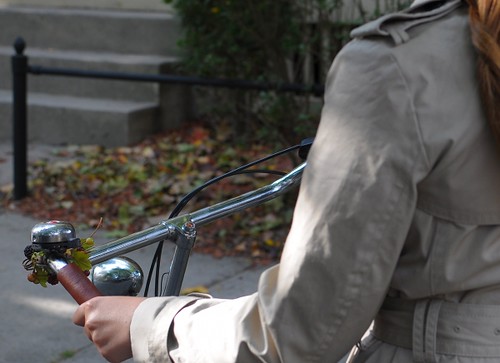 One last suggestion I can make for those whose clothing is wrinkle-prone, is to try throwing a coat on over the outfit. Granted, this works best in cooler weather, with stiff wool coats. But in warmer weather even a thin trenchcoat can be helpful.
One last suggestion I can make for those whose clothing is wrinkle-prone, is to try throwing a coat on over the outfit. Granted, this works best in cooler weather, with stiff wool coats. But in warmer weather even a thin trenchcoat can be helpful.


 We took the ATV's out the other day after a rain, to see how bad a shape the roads were in. Nothing to bad but a few were washed out some.
We took the ATV's out the other day after a rain, to see how bad a shape the roads were in. Nothing to bad but a few were washed out some.


























 For those who are not familiar with Mike Flanigan, I do not think it is an exaggeration to say that he is a legendary figure in the bicycle industry. Not only does A.N.T. put out a truly unique product, but Mike's background is impressive in itself. He started out in 1989 at
For those who are not familiar with Mike Flanigan, I do not think it is an exaggeration to say that he is a legendary figure in the bicycle industry. Not only does A.N.T. put out a truly unique product, but Mike's background is impressive in itself. He started out in 1989 at  Since discovering A.N.T. a year ago, I keep asking myself what exactly makes these bicycles so interesting and unusual? Others make TIG-welded frames. Others offer custom colours. And now that the concept of "city bike" has taken off, others build up bicycles designed for fenders, front and rear loads, and upright sitting. So what does A.N.T. offer that's different?
Since discovering A.N.T. a year ago, I keep asking myself what exactly makes these bicycles so interesting and unusual? Others make TIG-welded frames. Others offer custom colours. And now that the concept of "city bike" has taken off, others build up bicycles designed for fenders, front and rear loads, and upright sitting. So what does A.N.T. offer that's different? Ah yes - Personality. And I am not talking about Mike's own great personality. The
Ah yes - Personality. And I am not talking about Mike's own great personality. The  And then there is the fact that Mike himself is a kind, generous and creative person, who sticks to his principles and follows his philosophy. It is endearing to hear the younger framebuilding generation in the Boston area speak of him. Everyone seems to have a story about Mike having helped them out at some point, or taught them something; he is somewhat of a patron saint around these parts.
And then there is the fact that Mike himself is a kind, generous and creative person, who sticks to his principles and follows his philosophy. It is endearing to hear the younger framebuilding generation in the Boston area speak of him. Everyone seems to have a story about Mike having helped them out at some point, or taught them something; he is somewhat of a patron saint around these parts.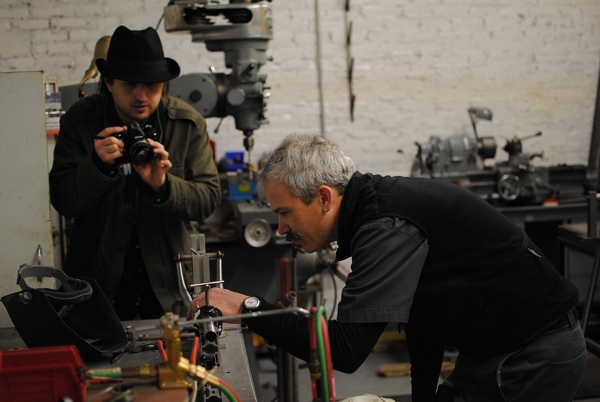 So that is the man we had the privilege to photograph last week, and we thank him for the opportunity.
So that is the man we had the privilege to photograph last week, and we thank him for the opportunity.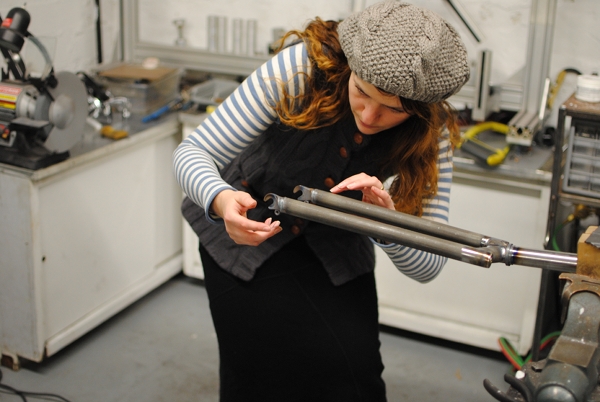 I enjoyed looking at all the tools and machinery in the A.N.T. workshop, and more than anything I loved examining this fork. It is a segmented fork that I believe goes on the Light Roadsters. There is something about the look of these that I find very cool.
I enjoyed looking at all the tools and machinery in the A.N.T. workshop, and more than anything I loved examining this fork. It is a segmented fork that I believe goes on the Light Roadsters. There is something about the look of these that I find very cool. Here Mike explains something to the Co-Habitant, as his Antique Scorcher poses in the foreground. To see some of the other bikes A.N.T. has made recently, have a look at their flickr sets. I wrote a test ride report of a Boston Lady's Roadster here, and I think the latest series of mixtes (especially the gold and the white one) are particularly beautiful. And of course I am very curious to see what Mike will be building for the North American Handbuilt Bicycle Show . I think he knows what my fantasy A.N.T. bike is, but that is another story entirely!
Here Mike explains something to the Co-Habitant, as his Antique Scorcher poses in the foreground. To see some of the other bikes A.N.T. has made recently, have a look at their flickr sets. I wrote a test ride report of a Boston Lady's Roadster here, and I think the latest series of mixtes (especially the gold and the white one) are particularly beautiful. And of course I am very curious to see what Mike will be building for the North American Handbuilt Bicycle Show . I think he knows what my fantasy A.N.T. bike is, but that is another story entirely!